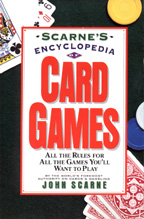
Scarne's Encyclopedia of Card Games
The Origins and History of Poker
Where did the poker come from and how did it get its name? These questions are very topical as more and more people are playing this popular game. Unfortunately, there isn't any cut and dried answer to either question, but there is plenty of speculation about both. Since people who invent games don't often record the process, we must entertain many possibilities.
Many have speculated that poker is related to a 16th century Persian card game called As Nas. With rules similar to today's five card stud, As Nas was played with a 20 card deck containing five suits. It had similar poker hand rankings, such as three-of-a-kind. A few are of the opinion poker was invented by the Chinese in 900 A.D. Scarne, in his Encyclopedia of Card Games, gives credit to French and German players who modified As Nas and called it poque or Pochen.
According to Scarne, there was a strong French influence in the first poker rules published in the United States:
The 32-card piquet pack was dealt from the bottom of the deck, and certain combinations of cards bore French names. The draw feature of Poker is found in Ambigu, and the blind, straddles, raise, table stakes, and freeze-out in the pre-Revolutionary Bouillotte. Bluffing and the use of wild cards were important features in the English game of Brag. In all these European games, however, a hand consisted only of three cards. The credit for the use of a five-card hand and also the bluff must go to the Persian As Nas, from which our word Ace may also have come.
In 1845 an early American edition of Hoyle included Twenty-Card poker and also “Poker or Bluff.” Twenty years later the American Hoyle added the game, calling simply “Bluff.” Perhaps a few players may have confused it with the English Brag also called that, but most players have always called it Poker. Game-book editors who do their research in previous game books sometimes still call it “Poker or Bluff,” although no player has used the latter term for nearly a century
Poker rules began to evolve in 1840 when a fifty-two card deck replaced the original twenty cards. Each player was dealt five cards face down. Only one round of betting was allowed. There was no additional draw of the cards. During the 1860s the draw and an extra betting round were introduced. By 1875 straights and flushes were part of the game.
References
David M. Hayano, Poker Faces, (Berkeley: University of California Press, 1982), pp. 8-9
John Scarne, Scarne's Encyclopedia of Card Games, (Harper & Row, 1983), pp. 6-7
